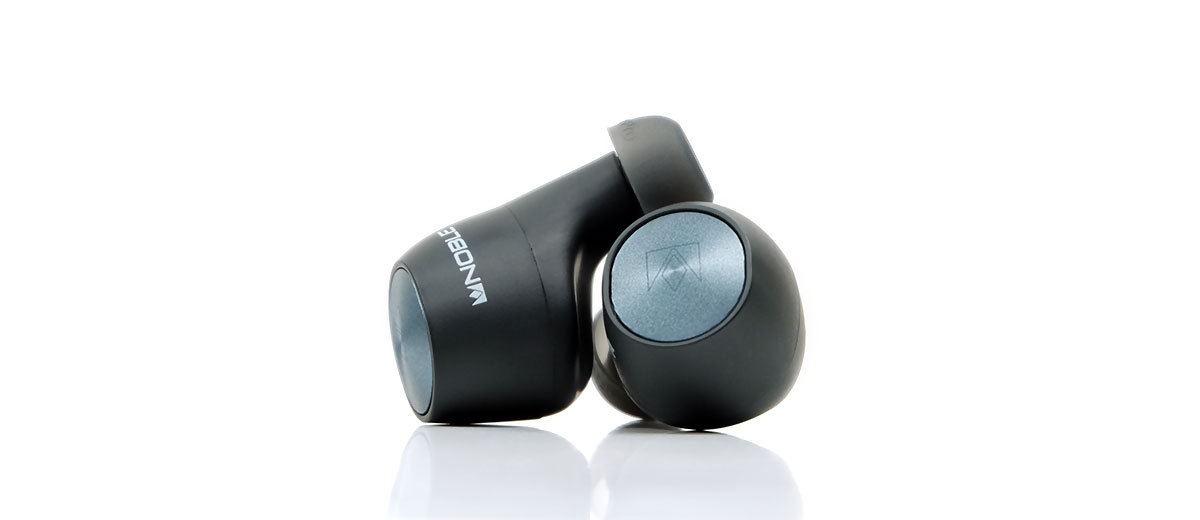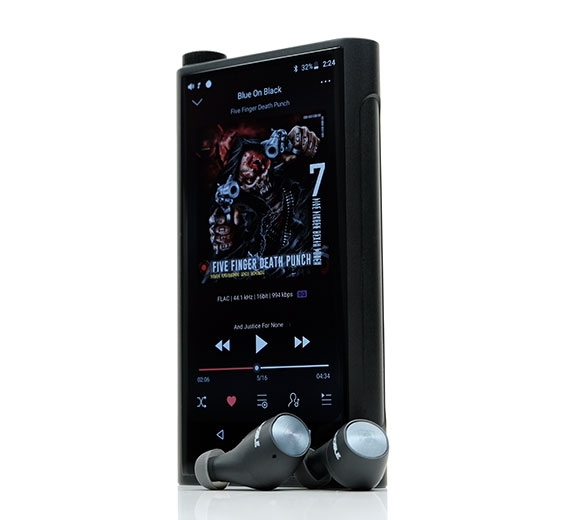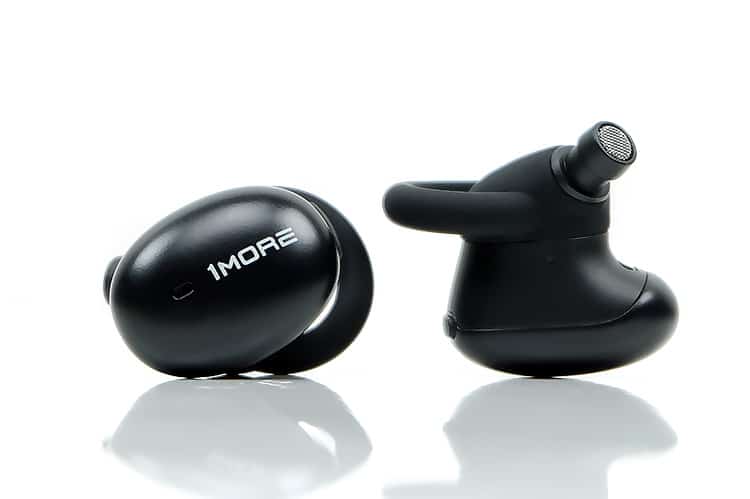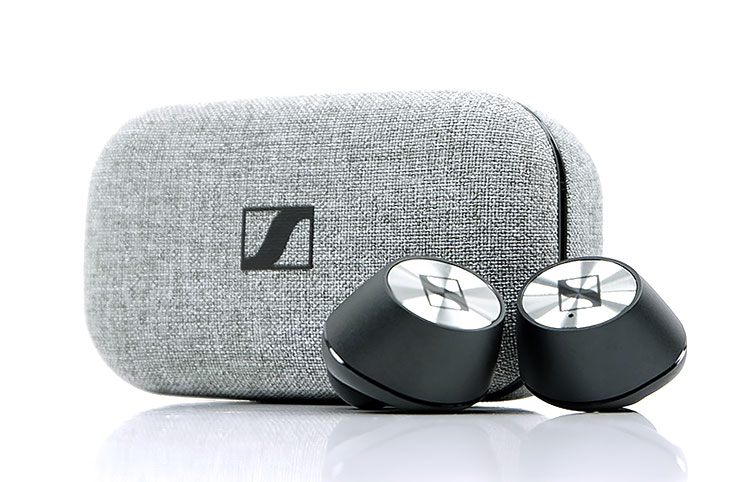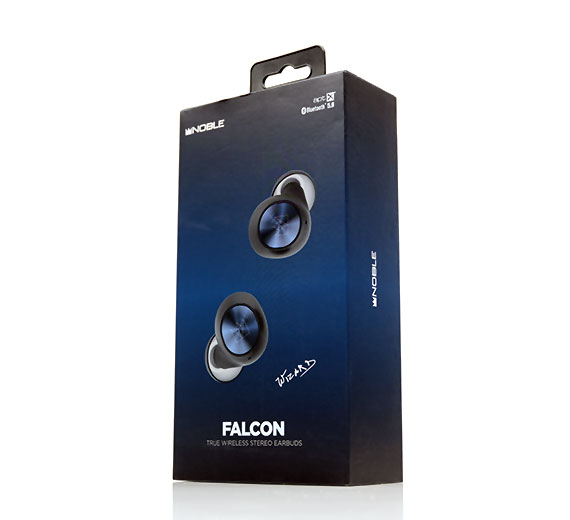Sound Impressions
Summary
The Falcon is a classic V-shaped presentation. What I mean by classic V is the amount of low-end weight and top-end sparkle. The balance between these two is excellent and significantly different from a lot of other supposedly V-shaped TWS drivers that sound a lot darker or warmer in comparison.
Low-end
So how is the Falcon balanced? Well, the low-end has some excellent depth but it is not a bloated sounding low-end either. From the elevated sub-bass, Noble has tuned a linear but steep drop into the lower-mids so mid-bass is not exactly to the fore nor does it bleed right up into the mids. It also has a nice sense of pace and a low-level of distortion for such as weighted tuning.
Lower-mids instrumental pitching does lack a little girth and wetness but the bass fundamental is strong as is the perception of power. The Falcon instrumental notes thus have a planted but clean sounding timbre overall but with a palatable level of clarity and above-average definition.
Top-end
Much of that clarity is drawn by a strong upper or odd-harmonic order so the higher up you go the crisper the sound gets. That is where the contrast comes in. The Falcon treble is elevated with plenty of energy right up to around 8-10k.
This is an airy sound and you will find the Falcon offering plenty of headroom as a result in its staging and dynamic prowess. However, it can also lead to a slight edge in some vocals where natural sibilance tends to be drawn out a bit more.
So, whilst timbre is much cleaner and spatial cues lively and easy to pick out, vocals have a slightly harder attack. Not so much as to sound strained and fragile like an overworked BA driver, there is still some excellent solidity to the treble delivery.
Staging
That level of elevation and contrast at both ends does mean quite a lot of midrange positioning is relatively distant sounding though I must emphasize that it is not in any way veiled. It does help to create a strong sense of space and openness to the Falcon soundstage but those looking for an intimate and rich vocal delivery will be left a bit wanting.
Vocals further up the register will have more presence and forwardness to them as well percussion positioning. Anything from 2k right up around 4k will come to the fore though again the tone is a little more to the precise and articulate than wet and smooth.
Wireless Performance
Pairing
Our testing for pairing to BT transmitters covered our usual bases, 2 smartphones, (Note 9 and P20), a DAP, (FiiO M15) and a Windows 10 laptop, (Acer Nitro 5). In all instances I found the pairing process to be very smooth and not OCD in terms of steps to pair the Falcon.
However, there is still an initial process and I found that the Falcon sometimes to bias to the left on initial pairing with some sources. That means you only need to pair the left to activate the right driver and receive a stereo signal or proper audio at whatever codec you choose.
After post pairing, this did not seem to be an issue with the right Falcon driver connecting first so the TrueWireless Stereo Plus seems to work just fine.
I would prefer it if the “L” channel label did not show in the scans and just the name “FALCON TWS” or something similar. I found this process to be similar on the smartphones and the Windows 10 laptop BT connections.
Stability & Range
This is the Noble Audio Falcon’s weak spot, at least compared to some of the TWS in the same price range. Stability is fine within its available range but on all connections outside of the M15, we found the range to be a little on the weak side and comparable to the Lypertek TEVI for distance.
That means a max of about 10m and one wall before the signal starts dropping out. It will not go beyond a second wall or into our kitchen enclave which places it behind the likes of the Fostex TM2, Sennheiser’s MOMENTUM TWS and behind the class cleaning HELM TW5.0.
The FiiO M15 dragged its heels behind the smartphones and our Windows laptop. I am not surprised by that. Most DAPs outside of the Sony 1Z are a bit behind modern smartphones for BT range and true enough signal stability began to suffer around 8m and we had some small dropouts by the 10m marker. That is not the fault of the Falcon, DAPs need to catch up on BT transmission strength.
Latency
Paired with a Windows 10 PC and using two H.264 media files via VLC the latency on the Falcon ran at about 0.2s hastened meaning there is some detectable lag in the audio sync. Depending on the quality of the decoding, you can get away with 0.1S hastened but it might not look as tight as 0.2s.
This places the Falcon in the middle of the pack for audio sync on media playback so I advise using something that can tweak that such as VLC if you intend to use the Falcon for movies.
Select Comparisons
1MORE Stylish True Wireless
$99.99
Technical
Like the Falcon, the Stylish uses a single dynamic driver, but different spec. This is a 7mm titanium competitive as compared to the 6mm dual-layered carbon driver inside the Falcon. Both have a Qualcomm QCC3020 BT5.0 capable chipset inside and can decode up to aptX standard.
The two systems use noise suppression DSP for call clarity but in the Falcon, it is cVc 8.0 and in the Stylish, it is called ENC. I believe both do the same thing however and it may even be the same tech but with different brand names. They also both use a level of integration with an app with a similar firmware upgrading process and EQ controls.
One major difference is the lack of IPX rating with the 1MORE Stylish whereas the Noble Audio Falcon has an impressive IPX7 rating. I do believe 1MORE has stated gym use is not an issue but it is comforting to know the Falcon is officially rated.
Battery
Both come in diminutive plastic cradles though I give the edge slightly to the egg contouring of the Stylish cradle. Battery life is much better on the Falcon, however, at 10 hours per driver and 30 hours in the cradle. The Stylish is good at 6.5 hours and 24 in the cradle but not Falcon level. Both do offer USB-C charging.
Design
The touch-controlled Stylish has a very different design approach to the physical button Falcon, particularly when it comes to fitting. The Stylish uses O-rings that encircle a deep plastic shell. This compensates for the very short nozzle and does help to keep the drivers nice and secure in the ear.
However, the Falcon’s long nozzle is more tip appropriate and leaves less to chance for sound quality from variable tip fitting. In short, the Falcon and Stylish fit well, seal to the same level but the additional nozzle length and Bette tips on the Falcon produce a more consistent sonic performance.
Performance
The Stylish was just marginally better for distance and stability but the extent of which will depend on your area layout. Both have stability up to 8-9 meters with one wall and the Falcon has slightly more drop out at 10m. With a second wall introduced at 11 meters both started to struggle using the two smartphones.
The Stylish is super fast to be picked up by our source BT transmitting devices, faster than the Falcon. The Note 9 found it immediately and paired immediately with no pause. The Falcon took about 1-2 seconds longer but otherwise the same simple process.
Latency checking on both with a Windows 10 VLC media file was very similar at a comfortable 0.2s hasten on the two H.264 files we tested.
Tuning
Both of these are V-Shaped but the 1MORE is rather darker in its tuning meaning it holds its elevation a bit higher in its mid-bass performance and drops slowly into the mids with far less treble sparkle.
The Falcon shows off a more balanced “V” for me with better bass/treble contrast. It sounds tighter, cleaner and airier than the Stylish’s warm and comparatively softer delivery. A few reasons for that.
On the Falcon, the sub-bass to mids is a linear drop so the mid-bass to lower-mids is on a downward curve. It is not without warmth but it doesn’t travel into the mids. The Stylish doesn’t drop as much with a slower curve from 100Hz down to almost 800Hz that carries that warmth up into the mids. Both have depth and a weighted low-end response but the Falcon’s depth comes with better definition whereas the Stylish sounds flabbier and slower.
The bump in the mids for vocals is nowhere near as elevated as the Falcon nor is the treble beyond 5k. You do not hear as much odd-harmonic infusion which creates that warm and soft sounding timbre. That does mean the Falcon can allow a bit of sibilance to creep into some vocal performances but I prefer that to the very soft attack of the Stylish vocal timbre.
Lypertek TEVI
£99.00
Technical
The TEVI is one of our top-performing TWS for sound quality and battery life it is a shade cheaper than the Falcon. I have to say both are top-heavy with some excellent features.
Both of these overlap quite heavily on features including BT5.0, aptX decoding, 10-hour battery life for the drivers, cVc 8.0 DSP noise depressing, IPX7 and apps integration.
The one key difference is the TEVI cradle battery life which is a mammoth 70-hour capacity compared to the 30 hours of the Falcon case. Then again, the TEVI case is much bigger to account for the larger battery.
Design
Both have similar two-piece plastic shells but the form factors are slightly different. The TEVI nozzle is shorter thus placing more emphasis on regular single bore silicone tips to finish the seal and keep them secure. The Falcon is longer, secures better and has tips that are more appropriate for the depth. The performance is more consistent as a result with a marginally better seal.
The finishing on the plates are also better on the Falcon with the blue plate and large LED glow. The TEVI’s are good but look a little drab by comparison.
The TEVI case, however, is a nicer finish with the nylon cloth cover on the top giving it a semi-Sennheiser Nordic look. It is bigger and more durable but not so big you cannot throw it in your pocket and feel uncomfortable. Both cradles are USB-C terminated.
Performance
Honestly, I cannot separate these two for latency and stability over range. Pairing also followed a very similar process with both able to connect either left or right after the initial pairing process.
Both tap out a little short on range and have signal drop out at the same 8-10m point with DAPs and 10m with the smartphones. Latency on both is around 0.2s for the two H.264 media files we ran.
Tuning
There are some differences here and it is pretty much down to how much “V” you want in your “V”. Both TWS are going for a musical experience, the Falcon, however, takes a different approach and has gone for a cleaner and slightly ‘contrastier’ tone than the TEVI.
By that I mean the timbre is cooler with more sub-bass and upper-mids and treble emphasis and a steeper dip into the lower-mids up to 1k. Vocals, though crystal clear on the Falcon, are a little leaner sounding than the TEVI.
The TEVI has less of a treble lift so it sounds more relaxed and liquid on the top-end. Vocals are similarly positioned compared with the Falcon but warmer sounding. The low-end of the TEVI and Falcon are not too far off except perhaps the TEVI has a little more mid-bass warmth and presence.
The TEVI also doesn’t seem to dip as low into the lower-mids so instruments have a little more fullness or meat on the bones but the better separation comes from the Falcon.
Overall, the Falcon is the taller, perceptibly more articulate and tighter sounding whereas the TEVI is the warmer, richer and smoother of the two.
Sennheiser MOMENTUM TWS
$199
Technical
At $199 street price, the Sennheiser MOMENTUMs are only $30 more now than the Falcon but may also be eclipsed by the interest in the MOMENTUM TWS 2 recently launched. They also share a lot in common with BT5.0, up to aptX decoding and apps integration.
They also differ in several areas. The first is the driver with the MOMENTUM using a slightly larger proprietary 7mm driver compared to the Falcon’s 6mm dual-carbon dynamic driver. The IPX rating on the Falcon is higher at 7 compared to the IPX4 of the MOMENTUM.
The MOMENTUM uses an accurate touch control system, one of the best. Whereas, the Falcon uses a more traditional physical button system aided by a large housing for an easier grip. Both have their pros and cons but I have to admit the Sennheiser system combined with aptX LL is killer.
The two systems have apps integration but the Sennheiser Smart Control system does have the benefit of their Transparent sound control to give you control on the amount of environmental noise impression which is something missing from the Noble Sound Suite.
Battery
Oh gosh, the Falcon all the way. Senn’s MOMENTUM TWS has some of the worst battery ratings, period! The Senn cradle looks a whole lot nicer with a lovely cloth finish and a strong chassis. However, with just 4 hours per driver, (if you are lucky) and 16 in the larger cradle its outflanked by the huge 10 hours and 30 in the cradle from the smaller Falcon case.
Design
The MOMENTUM TWS and Falcon are mainly plastic design but the Sennheiser feels the better quality build overall. That touch control faceplate is big and easy to work with from a user point of view. You never feel like you are messing with the sweet spot in the ear.
Which is just as well because they do not fit as securely as the drum tickling Falcons. That Falcon long nozzle outmaneuvers the MOMENTUM TWS short nozzle and has slightly less isolation. Both are relatively comfortable, however. I have no issues on the fitting on either though both stick out of the ear a little compared to other smaller units.
Performance
In terms of distance the MOMENTUM TWS is on par with the Falcon with both able to get around 10-11m but the MOMENTUM TWS was marginally more stable at 10m. Once we introduced the second wall at 11m the MOMENTUM edged ahead but not by a huge margin.
Pairing is so easy on the MOMENTUM with a very quick scan and find and a single name label which I prefer. Both have nice apps integration but I found the Falcon app to be a bit faster on the pickup of the driver signal than the Sennheiser version.
Latency, well the Sennheiser is king here in all our TWS tested to date requiring next to no sync on our Windows 10 VLC testing center for 2 movies in H.264 format. The Falcon needs that tweak of around 0.2s hasten to keep up.
Tuning
The MOMENTUM TWS is a warmer sounding TWS throughout with a bit more vocal emphasis, a relaxed treble and a slightly looser low-end though with plenty of quantity. I do think the Falcon sub-bass tuning has the better rumble of the two.
The Falcon casts a perceptibly bigger soundstage than the MOMENTUM but the sound is cleaner, leaner in timbre and body with a vocal positioning much further back, especially for male vocals. I also find the Falcon has the superior instrumental separation and works the detail a bit better than the MOMENTUM with that better treble presence and articulation.
The MOMENTUM TWS retains a bit more body and instrumental richness beyond the mid-bass. The lower-mids cut is not as deep as the Falcon so some bleed is inevitable to get that richness.
That continues into the 1-2k vocal range where the Senn sounds the smoother of the two. The Falcon sounds tighter but can also introduce a degree of edginess and enhanced sibilance by comparison.
I think this will be a preference choice because the Falcon is by far the better of the two for digital sounds, electronica and anything that needs a precise layering of sound or an expansive staging quality. The Senns tend to perform a little bit better when you need an inviting vocal and things get stripped down a bit more.
Our Verdict
The Falcon ranks up there with the TEVI in terms of killer features including app integration, 10-hour driver battery life, aptX, TrueWireless Stereo Plus, and IPX7. However, it sounds different and looks a bit different also.
It is a clever move to lengthen the barrel and bring in the ePRO tips instead of generic lifeless black silicone tips. I cannot say everyone will love the depth of insertion but I find it to my taste coming from my experience with CIEMs.
For those that want a high contrasting class v-shaped sound signature the Falcon probably is the most confident tuning I have heard to date. Sure, this is a consumer-type sound in some ways but in other ways, there are plenty of audiophile sensibilities thrown in to get that difficult balance just right.
The clean timbre, fast low-distortion bass response, and airy top-end should make the Falcon stand out a bit from the ‘warmer’ TWS crowd.
Falcon Technical Specifications
- Qualcomm QCC3020 (TWS Plus)
- 6mm Dual-layered Carbon Driver
- 5.0 Bluetooth / Class 2
- Compatible with A2DP, AVRCP, HSP, HFP, SBC, AAC, Apt X
- DC 3.7v 60mAH battery for each earpiece, and DC 3.7v 400mAH charging case
- 5.5 hours of continuous playback at maximum volume, and up to 10 hours of playback at 70% volume
- IPX7 water-resistant
- ePro ear tips
- USB C charging terminal

